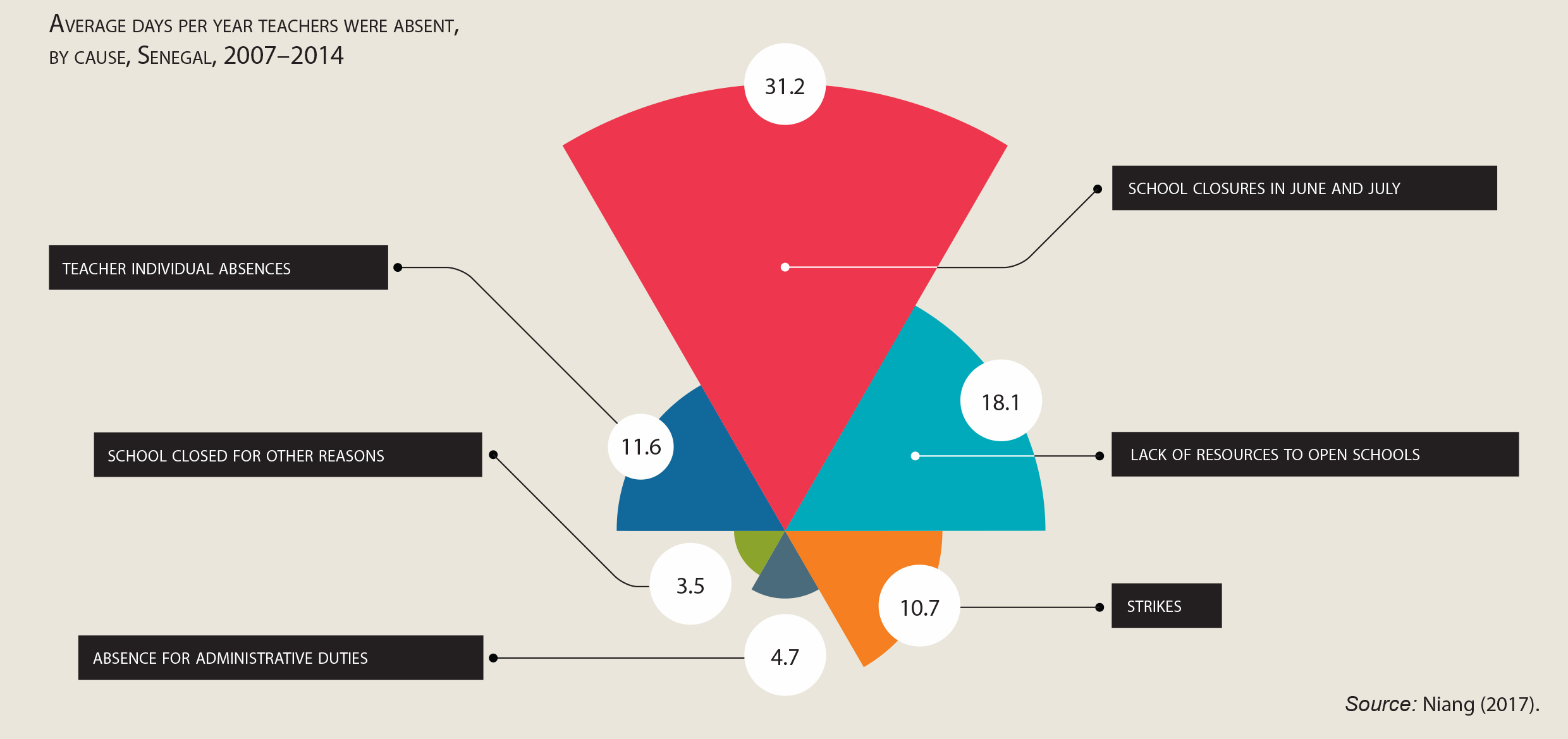Accountable teachers
Key Messages
- Teachers have primary responsibility for providing high-quality instruction, but they are expected to do far more than teach.
- Teacher absenteeism is a concern: A study of six low and middle income countries suggested it averaged 19%. But a closer look shows that this is often a problem of weak system or teacher management: In Senegal, schools were closed for 50 out of 188 official school days.
- Classroom observation is the core of teacher evaluations around the world. But the time and capacity development required to ensure it generates useful feedback to improve teaching should not be underestimated.
- In 33 education systems in mainly high income countries, 83% of lower secondary school teachers reported student surveys were part of their evaluation. However, an international review showed these were not based on informed analyses of teaching.
- Student test scores increasingly form part of teacher evaluations. But scores reflect more than the impact of a single teacher – and even isolating the effect of a particular teacher fails to recognize that scores are insufficiently reliable as indicators of teacher effectiveness.
- Teacher sanctions based on student test scores or evaluations are increasingly popular, but have multiple negative consequences for instruction, learning and equity.
- Performance-based pay tends to promote an unhealthy competitive environment, reduce teacher motivation and encourage teaching to the test, at the expense of weaker students.
- Professional learning communities are an accountability approach that has helped increase teachers’ pedagogical and content knowledge, with associated changes in practice. But they are less common in poorer settings, where mentoring and collaborative practices can be rare.
- Most countries have national codes of ethics developed by teachers’ unions, but lack of clear enforcement mechanisms hinders their effectiveness and codes do not always specify breach reporting or sanction mechanisms.
- Community monitoring of teachers has been used but often infrequently and is most effective when observations focus on easily identified and interpreted tasks, such as teacher attendance. Its usefulness for accountability purposes is especially poor for parents from disadvantaged backgrounds.
Teachers have the primary responsibility for educating students. In many countries, they face growing pressures. The complexity and variety of their tasks can put conflicting demands on their time, complicating efforts to hold them accountable.
PROVIDING HIGH-QUALITY INSTRUCTION IS TEACHERS’ CORE RESPONSIBILITY
Most countries allocate the vast majority of teachers’ work time to teaching. Formal instruction in some countries has expanded beyond core subjects into cross-curricular skills and social, behavioural and emotional competencies. Teachers participating in the Teaching and Learning International Survey (TALIS) spent about two hours a week on extracurricular activities, on average, ranging from one hour in Sweden to eight in Japan. Teachers also have responsibilities that are often not recognized or rewarded, which can lower motivation.
Teachers participating in the Teaching and Learning International Survey spent about two hours a week on extracurricular activities, on average
A study of six low and middle income countries in the early 2000s suggested that the average teacher absenteeism was 19%. However, the extent of teacher responsibility for absenteeism is often exaggerated. Between 2007 and 2014, Senegalese students received, on average, 108 of 188 official annual school days. Most reasons for absence were beyond teachers’ control (Figure 6). In Indonesia in 2013 and 2014, 10% of primary school teachers were absent. Nearly half these absences were excused time for study.
EVALUATING TEACHERS FOR QUALITY OF INSTRUCTION CAN BE HARD AND TAKES MANY FORMS
Government and public trust in the teaching profession, and teachers’ trust in the evaluation process, greatly influences the effectiveness of accountability approaches. In Finland, teachers originate and govern their own accountability policies, evidencing mutual trust among stakeholders. By contrast, trust in teachers in Japan declined upon underperformance on international assessments, and an increase in external accountability mechanisms has added reporting responsibilities to a workload already averaging 54 hours per week.
Contract teaching was initially a stopgap measure to overcome teacher shortages, but short-term teacher contracts are increasingly used as an accountability mechanism in low-trust environments, with contract renewal meant to incentivize improved performance. A dearth of tenured positions often coincides with increased staff workload, reduced public funding and diminished staff and organization rights. Contract teachers are also frequently underqualified, unsupported and underpaid.
Teachers’ trust in the evaluation process greatly influences the effectiveness of accountability approaches
FORMAL EVALUATIONS ARE THE MOST COMMON MECHANISM FOR HOLDING TEACHERS ACCOUNTABLE
Most countries evaluate teachers, using a variety of approaches. Classroom observations were used in evaluations for 96% of teachers in the mostly rich countries which participated in the 2013 TALIS. Observations are usually conducted by principals or management team members, and consequences vary. In Singapore, the information is mainly used for formative purposes; in Israel, observations are used in promotion. In the United States, ratings have often been poor at distinguishing teacher competence. Reliable and useful observation requires fine-grained, actionable feedback. Trained observers with subject and pedagogical expertise, including peer reviewers, provide more consistent feedback.
In the 2013 TALIS, 83% of teachers reported that student surveys were part of evaluations. Using student evaluations assumes students can recognize good teaching and report it truthfully. Reliability depends heavily on evaluation purpose and design and can be hindered by student bias. In France and Italy, teachers who gave higher grades received better evaluations. Teacher gender may also affect student perceptions.
Student test scores were the most common component of teacher evaluations in the 2013 TALIS, reported by 97% of teachers. However, test scores are influenced by many factors, including curriculum covered, student capacity, parental involvement, and school culture and resources. Scores alone are insufficiently reliable indicators of teacher effectiveness. More accurate evaluations use multiple sources, which may be difficult in under-resourced systems.
Teacher evaluations are increasingly consequential. Those who believe this approach to accountability can provide an effective response to perceived education problems typically assume (a) all education actors agree on desired outcomes that can be accurately measured; (b) responsibilities are clearly identified and communicated, and responsible actors have the ability to influence desired outcomes by themselves; and (c) chosen incentives will motivate action that produces desired outcomes.
But performance-based pay has a mixed impact on learning outcomes and can be detrimental to equity. It also tends to promote a competitive environment, which reduces teacher motivation, contrary to its intentions. Some studies suggest it affects female teachers more negatively than male teachers.
Teacher evaluations in high-stakes systems in richer countries have limited ability to improve instruction. The lack of actionable feedback and the focus on monitoring over improvement can reduce teacher satisfaction and cause many to view evaluation as merely an administrative task.
The reliability of student evaluations of teachers depends heavily on evaluation purpose and design and can be hindered by student bias
Education systems focused on accountability do not prepare teachers sufficiently
There is a clear trend of shifting instructional and management responsibilities to schools. Alongside the introduction of stronger accountability systems, this trend increases workload and requires additional skills on the part of teachers and school leaders, which can lead to grievances. In the United Kingdom, 56% of teachers reported that data collection and management caused unnecessary work.
Teachers need skills to assess student performance, analyse data and use them to inform instruction. But many teachers feel ill-prepared to use data. A study in the United States found that two-thirds of teachers lacked the facility to use data to improve instruction and often found the amount excessive.
The reliability of student evaluations of teachers depends heavily on evaluation purpose and design and can be hindered by student bias Teachers’ trust in the evaluation process greatly influences the effectiveness of accountability approaches
Many high income countries increasingly embed data literacy in teacher and principal preparation and professional development programmes. However, such programmes tend to focus on understanding reports, and few have student teachers practise using data for instruction. Also, programmes often emphasize technology rather than data literacy skills.
Minimizing data collection duplication can reduce the burden on teachers and principals. But the increasing trend of using data for education management also raises more general questions. First, the idea that learning improvement can be programmed ignores education’s social and cultural aspects. Second, the emphasis on learning outcomes that can be monitored may in fact serve primarily the accountability system, which is premised on a very narrow set of learning outcomes. Therefore, despite their usefulness, it is important to guard against taking data at face value. There should be more emphasis on using data diagnostically.
PROFESSIONAL ACCOUNTABILITY CAN SHAPE THE TEACHING CULTURE
Professional accountability is designed with teachers’ involvement and relies on their expertise and professionalism. Systems incorporating professional accountability generally result from public trust in the teaching profession to deliver high-quality education.
Peer learning can improve instruction. Typically found in middle and high income countries, professional learning communities provide structure for collaborative learning, involving sharing lessons with peers. The Lesson Study model, used in Australia; Hong Kong, China; Japan; Singapore; Sweden; the United Kingdom and the United States, uses collaborative planning, observation, analysis and refinement to improve lesson delivery and student learning. In England (United Kingdom), Lesson Study encouraged instructional risk-taking and reduced teachers’ feelings of isolation. Effective peer learning requires teacher autonomy and considerable time and resource commitments.
Most countries have teacher-developed codes of ethics to provide self-disciplinary guidelines via formulized professional norms. A review of codes of ethics in 24 countries found that many teachers did not know about them. Lack of clear enforcement mechanisms can also hinder effectiveness. Reporting mechanisms and sanctions are not always defined. Those evaluating misconduct should be trained.
CITIZENS CAN HELP HOLD TEACHERS ACCOUNTABLE
Community monitoring can be particularly useful in addressing teacher absenteeism. In Uganda, communitydesigned report cards reduced teacher absences. However, reliance on parents to hold teachers accountable is not sustainable. In Kenya, learning gains from parents monitoring and evaluating teachers wore off one year after the intervention concluded.
More systems are using technology to monitor teachers, despite concerns about trust and intrusiveness. Pakistan has monitored the attendance of over 210,000 education staff in 26,200 schools using biometrics. As of February 2017, 40,000 absent teachers and 6,000 absconders had been disciplined. Thousands of classrooms in China are live-streamed, allowing parents and the public to monitor and comment on teaching practices and student behaviour. Critics worry continual surveillance violates teachers’ and students’ privacy rights and could negatively affect instruction.
Engaging in teacher monitoring can be affected by socio-economic status, individual capacity and teachers’ attitudes. Disadvantaged parents often lack the skills, knowledge or confidence to interact with teachers. For such monitoring to be successful, both community members and teachers should be involved in deciding criteria and in designing accountability mechanisms, with clearly defined roles and responsibilities.
A review of codes of ethics in 24 countries found that many teachers did not know about them


